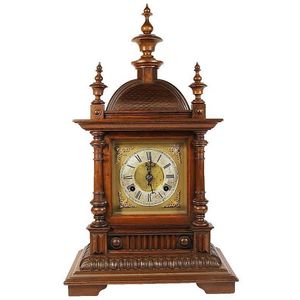German Walnut Mantle Clock with Fish Scale Carving
You must be a subscriber, and be logged in to view price and dealer details.
Subscribe Now to view actual auction price for this item
When you subscribe, you have the option of setting the currency in which to display prices to $Au, $US, $NZ or Stg.
- Pendulum - The pendulum was discovered around 1602 by Galileo Galilei, and was adopted for time keeping by the Dutch mathematician and natural philosopher, Christiaan Huygens, who excelled in astronomy, physics, and horology.
The pendulum comprises a metal rod usually of brass or steel with a metal disk, known as a bob, at the end. The movement of the pendulum is driven by weights or a spring, and as a pendulum swings in a regular arc, it was found accuracy could be controlled to within a few seconds a week.
Timekeeping can be adjusted by changing the height of the bob on the rod, making the pendulum either swing slower or faster.
The disadvantage of the pendulum was that changes in temperature also changed the length of the pendulum, interfering with the accuracy of the clock, and so in the 18th century two types of mercurial pendulums were invented which countered the movement in the steel rod.
The pendulum was the world's most accurate timekeeping technology until the invention of the quartz clock, regulated by a quartz crystal, in 1927. - Finial - An architectural decoration, found on the upper parts of of an object. On furniture they are usually found on pediments, canopies and shelf supports. On smaller ceramic or silver items, such as spoons, they may decorate the top of the item itself, or the lid or cover where they provide a useful handle for removal.
Finials have a variety of shapes and forms. They may be urn-shaped, baluster shaped round or spiral, but usually taper into an upper point. Many real life shapes may also be used as finials, such as pineapples, berries, pinecones, buds, lotus and acorns. Sometimes animals such as a lion are depicted, or fish and dolphins.
This item has been included into following indexes:
Visually similar items

A walnut cased mantle clock, later 19th century, crossed arrow mark for Hac, the Hamburg American clock Co, the clock with a white metal and engraved gilt dial with Roman numerals and pierced foliate spandrels surmounted by a mascaron and set within an arc

A Late Victorian Ebonised Eight Bell Bracket Clock, the Dial Signed Pridham and Sons, Torquay, Circa 1880, With a triple fusee movement, quarter striking with eight bells and striking gong on the hour, the silvered Roman numeral dial and subsidiary dials f

A late Victorian walnut cased three train bracket clock signed Webster / Queen Victoria St / London / 17726 with a triple fusee anchor escapement, gong and striking on eight bells, the silvered floral engraved Roman numeral dial and subsidiaries for chime/

An impressive architectural style Victorian bracket clock late 19th century, mahogany, likely Scottish, having a triple fusee musical movement, with bell striker dial with silent and chiming settings and with musical chimes, Whittington and Westminster. Th
